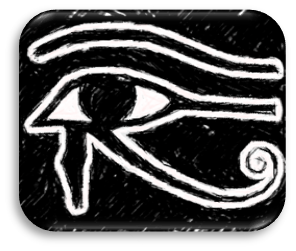Tihuanacu Star Maps
Enoch and the Watchers details a number of carvings as constellation charts, but the two most significant are included below. There are two keys to understanding these carvings. The first is the sunrise on the vernal equinox in the Southern Hemisphere, circa 10,300 BCE, +/-300 yrs. At this time and place, the predominant celestial body on the horizon is the Galactic Core, in which the Galactic Core and the sun are in conjunction – seen as one! The second key is the supernova of SgrA*, which would have been observed by the Watchers at the tip of Scorpius, next to the Galactic Core. This supernova created a plume of dust first documented at Tihuanacu, and later to be memorialized with the famous Eye of Horus necklace. The cover art of Enoch and the Watchers represents the Galactic core as the “eye” with the constellation Aquila to the left, and the constellation Serpens to the right. The Egyptians and others recorded Serpens under many different names and myths, such as Hathor, Apep, and Seth. The primeval Watchers recorded Serpens as a five-humped snake with a coiled tail. The coil was later transformed to the Scorpius Constellation, with the head of Scorpius leading into the Serpens Constellation of the modern era. With only a star constellation left behind to record its path, the Great Celestial Serpent was that plume of dust created by cosmic rays shooting across the galaxy.
For those who may be unwilling to accept that the carvings of Tihuanacu are that ancient, I challenge you to read Appendix IV: In Defense of Posnansky’s Dating. This section dissects and disarms the few arguments that critics of Posnansky have offered, and summarizes all the supporting archeological and geological evidence that is generally ignored by critics.
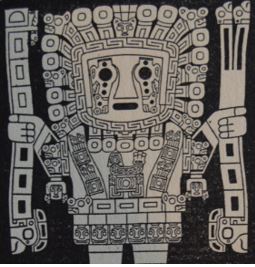
Staff
The two staff of Viracocha cannot be understood without reference to the mythology of Mesopotamia and Egypt.
- In Egypt, the original creator deity was named Ptah-Tanen (Tatenen), and known as Father of the Gods. Ptah-Tanen was father of Horus the Elder (Tanen), the night god, also known at Edfu as The Winged One.[1] Tanen is described as having two sacred staffs (named Segemeh and Sekhem-her), bequeathed by Ptah.[2],[3] Segemeh and Sekhem-her are “almost identical looking, both having a falcon-head upon which is fixed the spear-point… one has a solar emblem on the Falcon-Head”[4] Substitute condor for falcon and one has a description of the staffs held by the Viracocha.
- The Babylonians have a similar mythology referring to Ninurta (the earlier, Akkadian name for Marduk), who was symbolized holding two “maces” known as the two stars of the Scorpius Constellation: “Šarur and Šargaz.”[5] Šarur (Sharur, Car-ur) was the weapon used by Ninurta to defeat Asag (Akkadian name for Tiâmat), and was also know to appear as “a winged lion.” Ninurta was the son of the Akkadian/Sumerian creator Enlil.
“Šarur made the storm-wind rise to heaven, scattering the people…its venom alone destroyed the townspeople. The destructive mace set fire to the mountains, the murderous weapon smashed skulls with its painful teeth, the club that tears out entrails gnashed its teeth.”[6]
- Canaanite and Ugaritic myth also refer to the use of “two magic clubs” to fight Chaos – being the serpent demon Yam. Both Baal and the warrior-king YHWH are known to have possessed “Yagrush and Ayamur.”[7] (In this respect, YHWH at one point in mythology takes on a role similar to Marduk, Horus, Ninurta, Heracles -as the god king who restores order from chaos.)
The commonality of these myths, and the celestial location assigned to them by the ancients (in the stinger of Scorpius) suggests the assigned stars should be considered as the head of the staff of Viracocha.
- Šarur: more commonly known as Shaula (λScorpio, λSco) was known to the Babylonians as MUL.APIN. Located in the ‘stinger’ of Scorpius, it is often paired with its very close neighbor star named Lesath. (υLesath). Together, they were known as “Cat’s Eyes.” In translation, there appears to be some confusion whether Lesath originally meant “bite of a poisonous animal” or “the foggy patch.” If the latter translation is correct, the correct entity is not υLesath but rather the open star cluster M7 Acumen.
- Šargaz: more commonly known as Sargas (ϴ Sargas, Theta Scorpii, θ Sco, θ Scorpii). It is easily visible to the naked eye, and one of the brightest stars of the night.
When viewed from the southern hemisphere, using these two regions of the Scorpius Constellation as the staff heads provides a pathway for developing an image of the Viracocha. The staff heads appear at the intersection of two major celestial divides: The Galactic Equator and the Celestial Equator. The Galactic Equator is the foundation of the system of measures (latitude and longitude) by which space is measured from the Galactic Center, as measured by radio source Sgr A*. The Galactic Equator is 0° and the poles +/- 90°, with the equator running through the center of Milky Way. The Celestial Equator is a projection of the earth’s equator into space. Due to the Earth’s axial tilt, the celestial equator is inclined by an approximate 23.4° with respect to the ecliptic plane. (See Figure 114.)
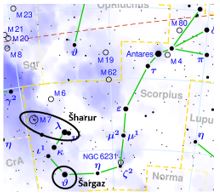
Figure 113: Staff Heads of Ninurta, Ptah-Tanen and Viracocha[8]
The staff originating at Sharur runs parallel to the Galactic Equator and through Sgr A*, where the right hand of the Viracocha appears to hold onto that staff. The point at which Galactic Equator runs through the region of Sgr A* is the same point at which the plane of the Ecliptic intersects with the Galactic Equator. The staff originating at Sargas runs parallel to the Celestial Equator, and the left hand of Viracocha would be found at the position of the star Iota Sagittarii (Iota Sgr, ι Sagittarii, ι Sgr). (See Figure 115.)
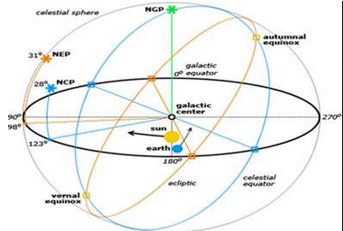
Figure 114: Viracocha Staff as Celestial and Galactic Equator[9]
Between the staffs, one would see the Corona Australis (Southern Crown) constellation. The Viracocha and Inti images all display a crown of twelve stars. Corona Australis today has thirteen Bayer class stars listed, but two of them (Kappa2 Coronae Australis κ2 CrA and Kappa1 Coronae Australis (κ1 CrA), create a line of sight double star, meaning they appear as one star. With the twelve stars, the aureoles display some combination of six beast heads: six lion heads; four snake and two condor heads; four lion and two double-snake heads. Corona Australis has two major clusters: The Coronet Cluster and Globular cluster NGC 6541. These might well represent the two condor heads, or two double condor heads. The four snake heads must then represent the major nebula objects. Corona Australis has four major nebulae: the Corona Australis Cloud, the reflection nebulas NGC6726 and NGC6727, and the planetary nebula IC1297.
With the discovery of these two components of the Viracocha image, and the identification of their stellar components, one can speculate the following:
- Star icon represents older, brighter stars;
- Condor head represents binary and globular clusters;
- Snake head represents emission and reflective (light) clusters of young stars;
- Puma represents dark nebula; and
- Animal heads flowing from the framed circumscribed sphere (Figure 116 B) represent nebula flowing from supernova.
This hypothesis is then validated by looking at yet other images found on the Viracocha. Below the aureole, in the Viracocha image, there is a five-piece necklace. Two images display necklaces having four condor heads and a star, and the one necklace has five stars. This interpretation suggests the five pieces are from left to right: NGC6595, Messier Object 22,φ Sgr (Nanto), Messier Object 54, and NGC6723.(See Figure 115.)
The bottom of the Viracocha’s robe varies greatly over time, from four snake to six snake. The six heads would represent from left to right, starting at the southern end of the Aquila (Eagle) Constellation: 1) Deneb el Okab (ζAql17, Aql), 2) Altair (α Aql -53Aql), 3) η Aql, η Aquilae 4) θ Aql-65 Aql. 5) Albali (ε Aqr, ε Aquarii) 6) Messier Object 30. Just above the bottom of the robe appears two puma heads at the ends of a snake torso, representing dark nebula. What is not seen is that to the right and left of the robe are the Serpens and Aquarius Constellations. Both of these, in myth, are associated with the dark cloud that brought the Great Deluge, and one can speculate that at this time, that nebula ran through this space.
The various versions of the staff generally incorporate the artistic imagery applied to the crown and aureole, with the ends of the staff being marked by either snake or condor heads. Interestingly, only two instances of the staff uses a puma head. One is found being held by the Viracocha on the Sun Idol, and another by a Winged-Bird-Man – both on older idols at Tihuanacu. In an older rendition of the staff, the staff is clearly presented as a serpent with a winding body, and several staffs use the same imagery found in the crown to represent the serpent ‘markings.’ The conclusion is that the staff is a specialized presentation of the cloud nebula, but it is being controlled by the holder. The staff, historically, is a weapon- both defensive and offensive. This lends the interpretation to suggesting the staff is a cloud nebula that has struck earth.
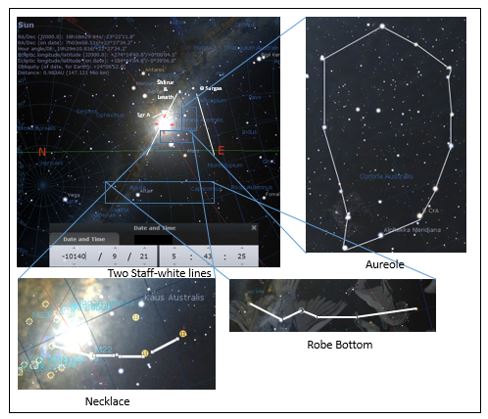
Figure 115: Viracocha Constellation
Two Staffs, Crown, Necklace, Robe Bottom and Left Hand of Viracocha representing a view of the Galactic Core circa 10,140 BCE on the vernal equinox, with the Sun in conjunction with the core, as seen from the current location of Tihuanacu.[10]
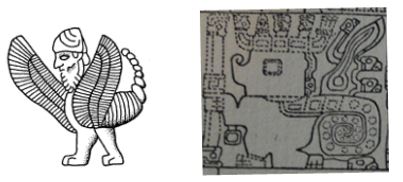
from Uruk seal(left) from Pachamama Idol(right), [1] where Pachamama image has wings, paws and curved tail.
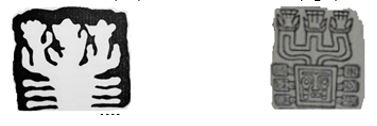
Figure 88: Scorpius on El Fraile & Pachamama Idols[2]
El Fraile (left) Pachamama (right)[3] The Sgr A* Supernova, initially seen on left and carved on el fraile Idol, was later stylized on the pachamama idol
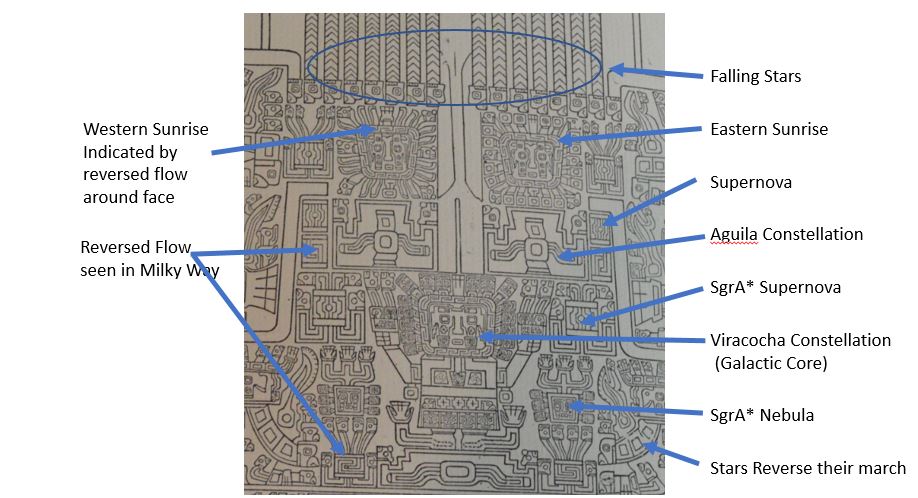
Figure 128: Pachamama Idol –Scorpius Next to Galactic Core with Aquila Constellation as supernova cluster above Scorpius, with dualistic presentation of geo-polar flip
Nearly all the representations of Viracocha, or a celestial deity such as Sirius, present the central character with an aureole of stars, clusters and nebula. In the case of Pachamama, the head of the idol is missing any of the standard aureole embellishments. Something different appears, which is a sixteen-star necklace, closely resembling the number of luminaries in the aureole. This necklace is seen in Figure 129.
Figure 129: Pachamama Idol Crown converted to Necklace[11]
This variance in style is made clear when one understands that the view of the Galactic Center changes at the northern latitudes, from a vertical stance of the eye, to a horizontal stance. With this change in perspective due to a 180°excursion, the Aurora Australis appears underneath the Galactic Center (rather than at the side) as it rises above the horizon, thus representing a necklace rather than a crown.
The necklace worn by the Pachamama Idol (Figure 129) has two pendants suspended from it, one above the other. (Figure 130) The upper pendant has a spiral direction of the Milky Way suggesting this idol was created while the Sun was rising in the West, while previously it has risen in the east. The upper pendant clearly displays, in size and order, the three stars of Orion’s Belt as it would be seen in a geographical polar reversal. The belt is preceded during sunrise by the five stars that usually represent the upper torso of Orion as envisioned by the Babylonians, with the brighter stars on the outer edge represented by the condor head. On the left and right, one finds more symbols not seen elsewhere, which may very well represent the very well-known nebula of Orion: Flame, Horsehead and “the Great” nebula. The ‘old’ view of Orion in the lower amulet would seem to be represented by the four major stars: Sirius, Rigel, Betelgeuse and Procyon as condor heads, and Orion’s belt in the crown. Rising in the east and viewed from the south, Orion’s belt would have been seen as a horizontal rather than vertical alignment. Together, these icons suggest, as does the architectural history of the Kalasasaya Temple, that the early inhabitants of Tihuanacu experienced a polar flip long prior to the Great Deluge of 9500 BCE, and that cataclysm was associated with the region of the stars now known as Scorpius. The timing for this cataclysm would be the last of the three world-destroying floods which preceded the Great Deluge of Noah. (Plato, Mesoamerican, Sumerian and Egyptian creation myth all relate there were three cataclysmic floods before the Great Deluge. See Chapter X)
All rights reserved, © 2016 by E. Peter Matrejek. Fair Use encouraged, but please acknowledge the book as the reference rather than the web site.
Footnotes
[1] This icon may represent the Basmu Serpent rather than a scorpion man.
[2] See opening photograph of the ‘El Fraile Idol” in Volume I of Posnansky. Image is found Figure 9, Item 1, page 122, Volume 1. Posnansky calls this image “the Crustacean.”
[3] Posnansky, Pachamama Idol, Vol 2.
[1] E.A.E. Reymond, Worship of The Ancestors at Edfu, in Chronique d’Egypte, Vol 38, No. 75, 1963, page 63.
[2] E.A.E. Jelinkova. The Shebtiw in the Temple at Edfu, in Zeitschrift für Ägyptische Sprache und Altertumskunde, Volume 87, Issue 1-2 (Dec 1962), page 44; E.A.E. Reymond, “The Origin of the Spear II,” Journal of Egyptian Archeology, Vol. 50, Dec. 1964, page 133.
[3] Tanen is translated to be “Adam”- the first man of Hebrew tradition, by Allen Austin, The Messianic Temple, self-published, 2011, page 56. Reference to The Winged One found in Eve A. E. Reymond, The Mythical Origin of the Egyptian Temple, Manchester University Press, 1969, page 28.
[4] Ragnhild Bjerre Finnestad, Image of the World and Symbol of the Creator: On the Cosmological and Iconological Values of the Temple of Edfu, Otto Harrassowitz Verlag, 1985, note 88, page 36.
[5] Gavin White, Babylonian Star-Lore: An Illustrated Guide to the Star-lore and Constellations of Ancient Babylonia, Solaria Publications, 2014, page 237.
[6] Black, J.A., Cunningham, G., Robson, E., Zólyomi, G., Electronic Text Corpus of Sumerian Literature, Exploits of Ninurta, lines 251-264.
[7] James Nogalski, Redactional Processes in the Book of the Twelve, Walter de Gruyter, 1993, page 166, Albert I. Baumgarten, The Phoenician History of Philo of Byblos: A Commentary, Brill Archive, 1981, page 73.
[8] Original file created by Torsten Bronger using the program PP3 on 2003/08/18. File: Scorpius constellation map.svg. This file is licensed under the Creative Commons Attribution-Share Alike 3.0 Unported license.
[9] http://www.visioninconsciousness.org/Science_B08.htm, No copyright.
[10] Images generated with Stellarium.
[11] Image from Bellamy and Allen.
All rights reserved, © 2016 by E. Peter Matrejek. Fair Use encouraged, but please acknowledge the book as the reference rather than the web site.
